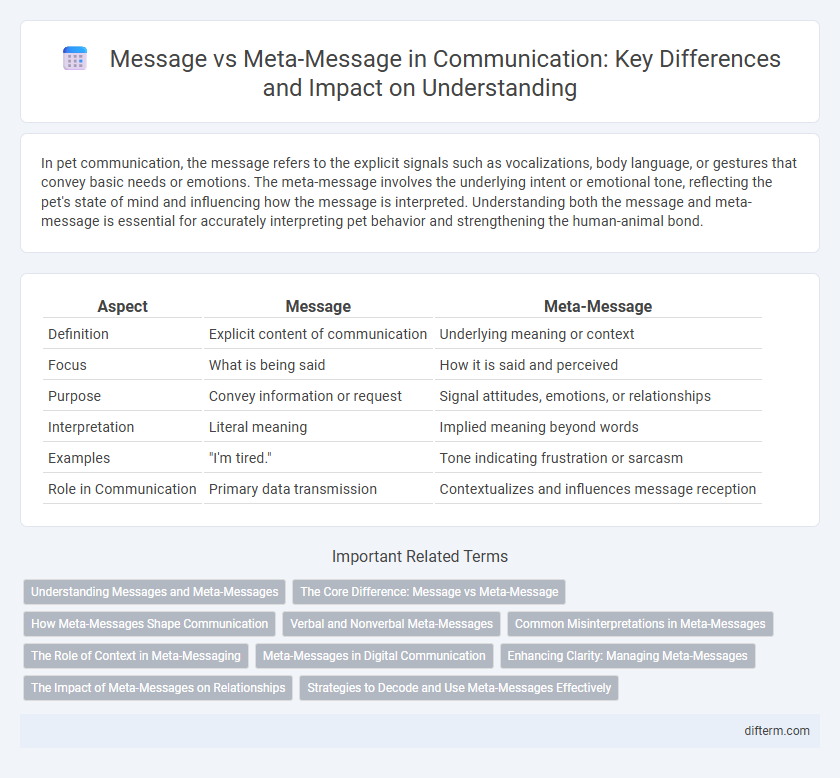In pet communication, the message refers to the explicit signals such as vocalizations, body language, or gestures that convey basic needs or emotions. The meta-message involves the underlying intent or emotional tone, reflecting the pet's state of mind and influencing how the message is interpreted. Understanding both the message and meta-message is essential for accurately interpreting pet behavior and strengthening the human-animal bond.
Table of Comparison
| Aspect | Message | Meta-Message |
|---|---|---|
| Definition | Explicit content of communication | Underlying meaning or context |
| Focus | What is being said | How it is said and perceived |
| Purpose | Convey information or request | Signal attitudes, emotions, or relationships |
| Interpretation | Literal meaning | Implied meaning beyond words |
| Examples | "I'm tired." | Tone indicating frustration or sarcasm |
| Role in Communication | Primary data transmission | Contextualizes and influences message reception |
Understanding Messages and Meta-Messages
Messages convey the explicit content intended by the sender, while meta-messages provide the underlying meaning or emotional context that frames the interpretation. Effective communication requires decoding both the verbal message and the meta-message to fully grasp the speaker's intent, tone, and relational cues. Misunderstanding meta-messages often leads to communication breakdowns despite the clarity of the explicit message.
The Core Difference: Message vs Meta-Message
The core difference between a message and a meta-message lies in their communicative function: a message conveys explicit information, while a meta-message provides context or commentary about how the message should be interpreted. Meta-messages often include tone, body language, and subtext that influence the receiver's understanding beyond the literal words. Effective communication requires awareness of both the content of the message and the underlying meta-message to ensure clarity and prevent misinterpretation.
How Meta-Messages Shape Communication
Meta-messages shape communication by conveying underlying emotions, attitudes, and social cues beyond the literal content of the message. They influence how the primary message is interpreted, often dictating the tone, intent, and relational dynamics between communicators. Understanding meta-messages enhances clarity and reduces misunderstandings in interpersonal and organizational communication.
Verbal and Nonverbal Meta-Messages
Verbal meta-messages convey underlying meanings through tone, pitch, and emphasis, shaping the listener's interpretation beyond the literal message. Nonverbal meta-messages include body language, facial expressions, and gestures that reinforce or contradict spoken words, significantly impacting communication effectiveness. Understanding both verbal and nonverbal meta-messages is essential for accurate message decoding and improving interpersonal communication skills.
Common Misinterpretations in Meta-Messages
Meta-messages often convey underlying emotions or intentions that differ from the explicit content of the message, leading to frequent misunderstandings in communication. Recipients may misinterpret tone, body language, or context cues, causing confusion between the intended and perceived meanings. Clear awareness and clarification of these nonverbal signals are essential to avoid common misinterpretations in interpersonal exchanges.
The Role of Context in Meta-Messaging
Context shapes the meaning of meta-messages by influencing how non-verbal cues, tone, and implied meanings are interpreted in communication. Meta-messaging conveys emotions or relational information beyond the explicit message, relying heavily on contextual factors such as cultural norms, situational variables, and interpersonal dynamics. Effective interpretation of meta-messages enhances mutual understanding and reduces miscommunication by aligning the sender's intent with the receiver's perception within the given context.
Meta-Messages in Digital Communication
Meta-messages in digital communication convey the underlying tone, emotions, and context beyond the explicit content, influencing interpretation and response. Emojis, punctuation, and message formatting serve as key tools to express meta-messages, enhancing clarity and emotional nuance in text-based interactions. Understanding meta-messages improves digital communication effectiveness by reducing misunderstandings and fostering deeper connection.
Enhancing Clarity: Managing Meta-Messages
Meta-messages, the underlying tones or nonverbal cues accompanying verbal communication, significantly influence message interpretation and clarity. Effective management of meta-messages involves aligning body language, facial expressions, and vocal tone with the intended message to prevent misunderstandings. Enhancing clarity requires awareness and control over these meta-communicative signals to reinforce the explicit content and ensure accurate reception.
The Impact of Meta-Messages on Relationships
Meta-messages, the underlying emotions and attitudes conveyed beyond the explicit content of a message, profoundly shape relationship dynamics. They influence trust, understanding, and emotional connection by signaling intentions and feelings that words alone may not fully express. Recognizing and interpreting meta-messages accurately enhances communication effectiveness and fosters stronger, more empathetic relationships.
Strategies to Decode and Use Meta-Messages Effectively
Understanding the difference between message and meta-message is crucial for effective communication, as meta-messages provide contextual cues about the emotions, intentions, or attitudes underlying the main message. Strategies to decode meta-messages include paying attention to nonverbal signals such as tone, facial expressions, and body language, which often reveal deeper meaning beyond words. Using meta-messages effectively involves aligning verbal content with accompanying nonverbal cues to ensure clarity, build trust, and enhance interpersonal understanding.
message vs meta-message Infographic

 difterm.com
difterm.com